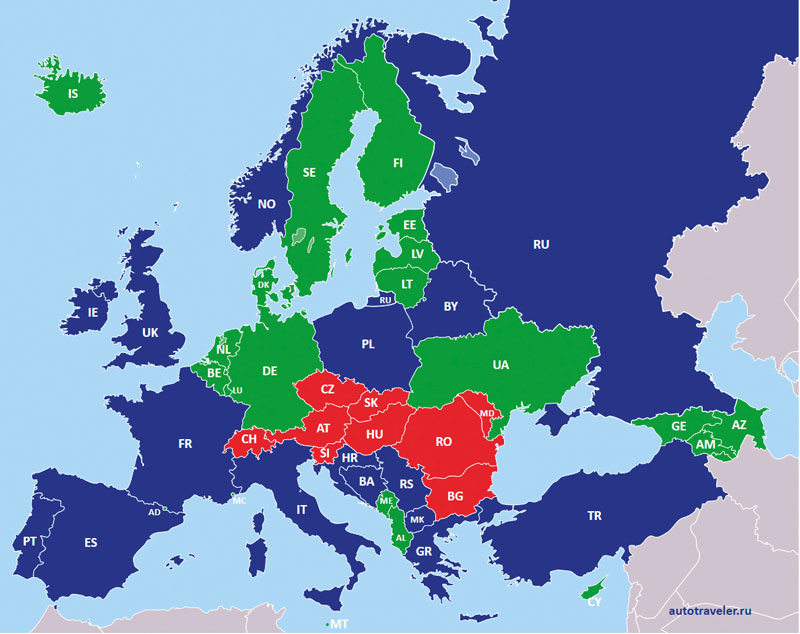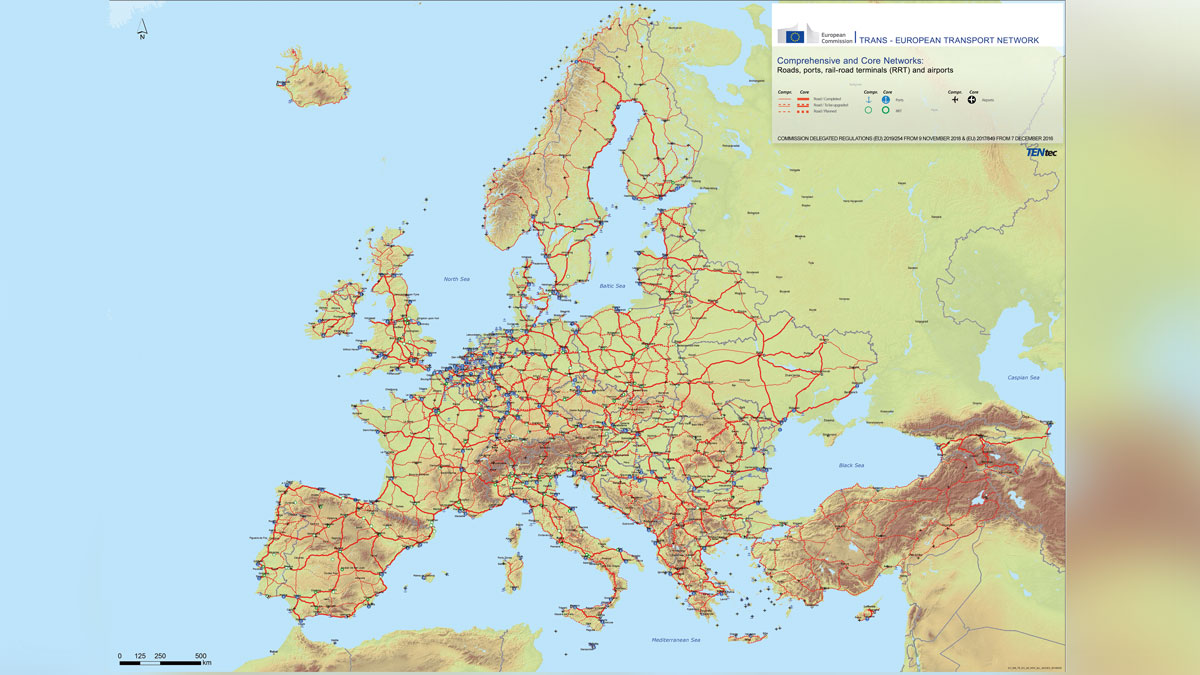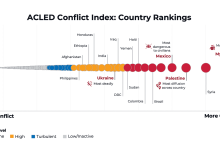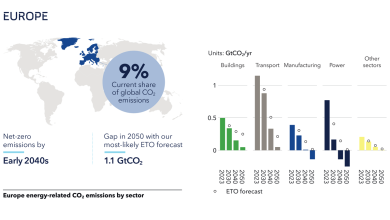Motorway Network in Line with a Green Europe
The European motorway network represents 80,000 kilometres. Although motorways account for only a small part of the entire road network, their length has tripled over the past 30 years. This spectacular growth can be noticed for Greece and Spain. In 2000, the most extensive motorway network in the EU was in Germany, followed by France and Spain. Over the past few years, the length of the EU motorway network has increased by 20%, but the growth is not relevant, as some motorways have also been subject to an increase in the number of lanes. The densest motorway networks were built in the Netherlands, Luxembourg, Cyprus (around Paris and in the north of the country in France).
Europe supports the construction of roads, tunnels, and electric lines to facilitate trade between the member states, economic development, and energy transition.
The largest motorway construction project in Europe
Poland has been and continues to be an important country for transit from north to south of Europe and from west to east. The construction of a new motorway provides multiple advantages for trade and economy in Poland and in Europe. The future A1 motorway is one of the most important 10 transport axes crossing Europe from the Atlantic to the Volga and from Scandinavia to the Mediterranean. Once fully developed, it will connect the Baltic seaport of Gdansk with Vienna and southern Europe, via the Czech city of Brno and the Slovakian capital Bratislava. 582 kilometres of this route will be on Polish soil. Works at the first construction phase started in the end of 2005. It runs from Rusocin to Nowe Marzy.
European strategy for Romania: Sibiu-Pitesti Motorway
Europe grants EUR 875.5mln for the construction of Sibiu-Pitesti motorway. The first phase of the motorway that links the cities of Sibiu and Pitesti, in Romania, will be funded by the European Union and the motorway represents a strategic stake for Europe. It would ensure a better connection along the Rhine-Danube transport corridor. It will result in an uninterrupted link between the Port of Constanta, opening to the Black Sea, and the Nadlac border point, to Hungary. However, this construction takes time and will be the first motorway crossing the Carpathian Mountains. No less than nine tunnels will be built to make this link possible. The Sibiu – Pitesti motorway will have a length of 122.11 kilometres and will be split into five lots. Construction works at the first lot, between Sibiu and Boita (13.17 km), started in March 2020. This lot will cost EUR 125mln and should be delivered within four years. Road infrastructure is far behind in Romania compared to the rest of Europe.
Top European motorways
Regarding the regional service, highly urbanized port and/or industrial areas predominate, for example in the west of the Netherlands, at a territory of 1,000 km2, there are over 100 km of motorways. Although unbelievable, high-GDP regions do not necessarily have a high density of motorways. The exception is represented by Düsseldorf and Köln (Germany) and the Madrid Community (Spain), where the motorway network is particularly dense.
Per capita, Cyprus has the most kilometres of motorways (36 km per 100,000 inhabitants), ahead of Luxembourg (32 km/10,000 inhabitants), Slovenia (28 km) and Spain (26 km).
Per km2, the Netherlands is the country the most densely covered by motorways (63 km per 1,000 km2), followed closely by Luxembourg (57 km) and then Germany (35 km) and Switzerland (33 km). The density of motorways in the Netherlands is three and a half times higher than the EU average (18 km). The length-to-surface ratio of the motorway can reach up to 220 km in Lisbon, which is well ahead of other urban areas (Bremen 176 km) and then Greater Manchester in the UK (140 km), and Düsseldorf, Hamburg and Vienna are also among the first ten.
In three states of the European Union there are no motorways: Malta, Latvia, and Estonia.
Speed limits on European motorways
130 km/h or 110 km/h? Most European countries have adopted limits of 120 or 130 km/h and motorways without maximum speed limit remain (for now) a German feature. Among the countries that have set the threshold at 110 km/h and even lower we find the UK (113 km/h), Cyprus (110 km/h), Estonia (110 km/h), the Netherlands (100 km/h) and Norway (80 km/h).
The most dangerous road in Europe
The most dangerous road in Europe is located in eastern Romania: national road 2, section E85. A road that links Bucharest to the Ukrainian border. Every year, in Romania, there are over 2,000 deaths and 40,000 seriously injured in road accidents.
Motorways in Europe: toll free or with tolls?
In the European Union, twelve countries provide access to motorways without financial contribution, although some have exceptions: Germany, Denmark, Belgium, Cyprus, Finland, Latvia, Lithuania, Estonia, Luxembourg, the Netherlands, Sweden, and Spain, which will renew their concessions to motorway administrators.
The exceptions from toll free motorways are, most often, for certain bridges or tunnels, whose use requires the payment of a fee. For example, the Øresund bridge, which links Sweden to Denmark, costs EUR 62. In Belgium, you need to pay EUR 6 to go through the Liefkenshoek tunnel in the Anvers region. Lithuania has introduced a tax for vehicles with nine or more seats in the form of a sticker of EUR 20 per day, EUR 60 per week, EUR 150 per month and EUR 600 per year. As for Germany, motorways were to become taxable, thanks to a system of vignettes and increased fares for the most polluting vehicles; however, the Germans have the option of being reimbursed for the amounts spent on taxes in the form of tax deductions. The Court of Justice of the European Union has considered the system discriminatory, and it had to be abandoned.

Payment through vignette: Romania, the cheapest country
This price policy exists only in Central and Eastern Europe. It is practiced by seven countries of the European Union: Austria, Hungary, Slovakia, Slovenia, Bulgaria, Romania, and Czechia. In principle, you buy a sticker that you stick on the windshield and all the country’s motorways are accessible. Some countries have computerized their sticker payment system.
The states that apply the most expensive vignette systems are Austria, Hungary, and Slovenia. The year-round sticker costs EUR 87.30 in Austria. In addition, an additional toll is paid for the use of certain sections of motorway, with prices ranging from EUR 5 to EUR 25. In Hungary, 30% of motorways do not require the purchase of a vignette, but on the rest of the motorway network, its price is around EUR 130/year. The tariff for Slovenia is EUR 110/year.
Romania is the cheapest country in terms of vignettes. The price is only EUR 28 for the full and unlimited use of motorways for one year. In turn, Bulgaria has a maximum price of EUR 50 per year.
Taxation system
The countries where motorways are paid through tolls are the countries with the highest costs in the European Union. Seven states apply this system: France, Italy, Portugal, Greece, Croatia, Ireland, and Poland. For example, Poland has been implementing an electronic payment system since January 2012. The kilometre costs on average, a modest amount, a little over 2 euro cents.
Motorways of Latin countries, the most expensive tariffs in Europe
Latin countries are, in general, the most expensive in Europe when it comes to motorways. For example, in Italy, the Florence-Rome trip costs EUR 18.4 per 100 kilometres. In France you need to pay on average EUR 7 per 100 kilometres.
The highest motorway in Europe
The A75, on its Lozère side, is the highest motorway in Europe, and its highest point is at the Col des Issartets, at 1,121 meters (France). The A75 motorway, 335 km long, crosses six departments: Puy-de-Dôme, Haute-Loire, Cantal, Lozère, Aveyron and Hérault and is an important link in the national road network.
Road rankings in 141 countries, by quality
Each year, the World Economic Forum reports on the international competitiveness of 141 countries. This report highlights many aspects, including that of road quality.
Singapore has the best infrastructure, with a score of 6.5 ahead of the Netherlands (6.4) and Switzerland (6.3).
With a rating of 6.6, France held until 2012 the first place in this ranking. But now the situation has changed a lot, due to the ever-increasing traffic, the very hard winters, and the ever-decreasing maintenance investments. Therefore, the roads are damaged.
After being knocked off its pedestal in 2015, to 7th place, France experienced another significant decline in 2020, dropping to 18th place, with a score of only 5.4.
The worst motorways in Europe
The five European motorways classified as ‘inadequate’ are located in Belgium, Spain, Czechia and Serbia. The worst ranked of all is the Ruma area in Serbia, on the A1 between Pcinci and Ruma. There is no indoor play area for children, a changing table or highchair in the restaurant, a parking space, or toilets for the disabled. In addition, the toilets turned out to be very dirty. Despite the high price, French motorways are almost average. Of the eight service areas tested in France, only two are classified as ‘good’ and 6 as ‘acceptable’.
The best 10 European roads
Amalfi Coast, Italy: Stretching along the north coast of the Gulf of Salerno, a drive through the Amalfi Coast starts in Rome and ends in Tivoli and can take nine hours and 36 minutes over 717.8 km.
From Berlin to Munich, Germany: Berlin and Munich are two of the best cities in Germany that many tourists must visit. One can drive from Berlin to Munich in nine hours and four minutes, covering 584.5 km on the A9.
Route 500, Germany: The Bundesstraße 500 is a federal motorway in Germany that is intended primarily as a tourist route. What makes it one of the best road trips in Europe is the heights of the Black Forest that one can cross in a north-south direction. Route 500 has two road segments, with a gap between that hasn’t been closed yet. The Freudenstadt to Baden-Baden route is 55.9 km long via the B294 and B462 and can be covered in an hour and a minute. The section from Triberg to Waldshut, on the other hand, has 89.8 km via B33 and B314 and can be covered in one hour and 20 minutes. Driving time will vary depending on traffic.
From Edinburgh to Inverness, Scotland: Edinburgh and Inverness are two popular routes to Highlands if you want to take a trip in Scotland. Traveling from one city to another covers 251.22 km via the A9, with a driving time of about three hours. Edinburgh is the second largest city of Scotland, while Inverness is the smallest.
Grossglockner Hochalpenstrasse, Austria: Among the popular routes for the best road trips in Europe, Grossglockner Hochalpenstrasse (Grossglockner Alpine Road) is the most interesting; the road will start at Bruck, in the Salzach Valley, via Ferleiten and will be covered in just an hour and a half over 48 km.
Ring of Kerry, Ireland: Located in Kerry, the route crosses the Iveragh Peninsula. Along the circular route 179 km long, there are coastal landscapes, villages, including the rocky island of Skellig Michael. The Ring of Kerry stands out as one of the most scenic roads of Ireland. It runs from Killarney and ends in Glenbeigh, before returning to Killarney through N72. The journey takes an average of 3.5 hours.
From Helsinki to Lapland, Finland: Helsinki is located on a peninsula in the Gulf of Finland. Lapland, on the other hand, is located in the northernmost region of Finland, and in 11 hours and 45 minutes you can reach Lapland from Helsinki or vice versa. The route covers 1,004.2 km via E75 and E75.
Ring road, Iceland: Also known as Route 1, the ring road is a national road that runs around the island of Iceland and connects most of the inhabited parts. Covering 1,332 km, the route reaches Selfoss from the east of Reykjavík and back.
From Paris to Berlin: Whether you travel from Paris to Berlin or vice versa, the distance is 1,054.1 km on the A2 for 10 hours and 52 minutes.
Catalonia – Road to the Sun, Spain: Located in north-eastern Spain, the region of Catalonia covers an area of 32,108 km2 and includes the provinces of Barcelona, Lleida, Girona, and Tarragona. For a short one-hour journey, it runs from the Portbou to Caldes de Malavella via the N-260 and AP-7 (95.3 km).
From Dubrovnik to Pula, Croatia: The distance is 1,100 km and the trip takes seven hours.
The Atlantic Road, Norway: It is also known as the Atlantic Ocean Road and covers a section of County Road 64, which stretches for 8.3 km and passes through an archipelago in Norway. It is also one of the 18 national tourist routes. It takes two to three hours to reach the continent from the beginning of the road in Utheim on Averøy. Located in northwestern Greece, the Epirus region covers 9,203 km2 and includes four regional units – Arta, Ioannina, Preveza and Thesprotia. It is one of the best road travel destinations in Europe.
Budva – Kotor – Durmitor – Piva, Montenegro: Montenegro covers 13,812 km2, which means it is a long road, but there is also the route Budva – Kotor – Durmitor – Piva, less than four hours for 261.4 km.
Tuscany, Italy: The journey can start in Florence and reach Pistoia in about eight hours via Poppi, Arezzo, Siena, San Gimignano, Livorno, Pisa, and Luca, covering 432 km.
2021, the European Year of Railways
Despite the heavy traffic on European motorways, rail transport was crowned in 2021. As the European Commission reports, the railway sector is responsible for less than 0.5% of greenhouse gas emissions from transport in the EU. Promoting rail transport is therefore an adequate means of achieving the objectives of the European Green Deal, which provides for a climate-neutral Union by 2050. This is the reason why the EU has declared 2021 the ‘European Year of Railways’. Therefore, several initiatives, projects and events are outlined, which highlight the railway sector and promote its development, in line with Europe’s climate and environmental goals.







